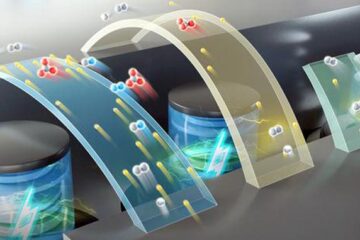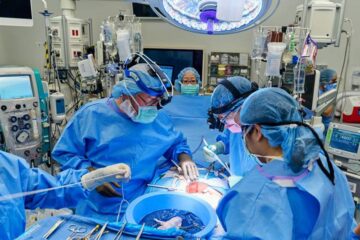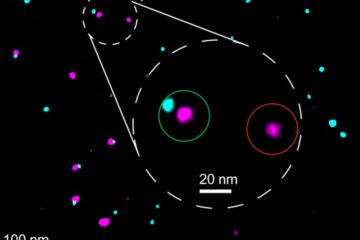RRF Recycles Form, Not Exact Function

Ribosome Recycling Factor Mimics Shape, But Not The Functions of Transfer RNA
RRF Protein Offers Potential Target for New Antibiotics
The fact that ribosome recycling factor (RRF) looks a lot like transfer RNA (tRNA) has not been lost on scientists. After all, both molecules are an important part of a bacteria’s ability to create new proteins. Researchers at the University of Pennsylvania School of Medicine and the University of Southern California, Santa Cruz, however, have found that this case of molecular mimicry has more to do with the shape of the molecules and not necessarily the job they perform. Their structural analysis of the RRF ribosome complex, presented in the current issue of the journal Cell, shows that RRF does not bind to the ribosome in the same location as tRNA.
“It is said that form follows function, but we see here that is not always true,” said Akira Kaji, PhD, from Penn’s Department of Microbiology. “The L-shaped structure of both RRF and tRNA may have more to do with the spatial constraints of maneuvering within the folds of the ribosome than their actual tasks.”
The actual task of the ribosome recycling factor has been something of a mystery for researchers. Until recently, science was unaware of its role in the process of creating proteins – and its potential as a target for new antibiotics.
Protein manufacture is a fundamental process of life that has been understood better in concept than in mechanics. While the DNA may encode the blueprints used to create proteins, it is the ribosome – an organelle within the cell – that actually builds a new protein.
There are three steps that are generally considered part of the scientific dogma surrounding the creation of new proteins: Initiation (the start of building a protein from messenger RNA that has been transcribed from DNA); Elongation (adding new amino acids to chain that becomes the protein via tRNA); and Termination (capping the amino acid chain off, so that it can be folded into a protein).
“There is one more crucial step that we had missed for a long time: recycling,” said Kaji. It is the step where the machinery of the protein synthesis is “recycled” so that they can be used for the next round of protein synthesis. This step does not happen by magic, and we have to ask – How do you disassemble the complex of the protein synthesis machinery so that they can be used again for the next round of translation?
According to Kaji and his colleagues, RRF binds to different locations within the ribosomal complex at different times. It seems that, if the ribosome is the protein factory, the RRF is the foreman, moving from location to location to ’supervise’ the end of the assembly line. When the new protein is completed, RRF works in conjunction with other proteins to disassemble the ribosomal complex so that the components of the machinery are ready for the next round of protein creation.
Kaji believes that, since RRF plays the key role only in bacteria and mitochondria, the bacterial protein also provides an interesting target for new types of anti-bacterial agents. His research has already shown in the laboratory that bacteria lacking RRF cannot exist because of their inability to create new proteins.
“As bacteria mutate to become resistant to antibiotics, we must keep targeting parts of bacteria that are integral for functioning so that bacteria can not out-evolve antibiotics,” said Kaji. “We are considering RRF as the target of a new type of antibiotic, an inhibitor of RRF that we can easily alter as bacteria become resistant.”
Other scientists contributing to the research presented in Cell include Michael C. Kiel of Penn and Laura Lancaster and Harry F. Noller of the University of California at Santa Cruz.
Media Contact
More Information:
http://www.med.upenn.edu/All latest news from the category: Life Sciences and Chemistry
Articles and reports from the Life Sciences and chemistry area deal with applied and basic research into modern biology, chemistry and human medicine.
Valuable information can be found on a range of life sciences fields including bacteriology, biochemistry, bionics, bioinformatics, biophysics, biotechnology, genetics, geobotany, human biology, marine biology, microbiology, molecular biology, cellular biology, zoology, bioinorganic chemistry, microchemistry and environmental chemistry.
Newest articles

High-energy-density aqueous battery based on halogen multi-electron transfer
Traditional non-aqueous lithium-ion batteries have a high energy density, but their safety is compromised due to the flammable organic electrolytes they utilize. Aqueous batteries use water as the solvent for…

First-ever combined heart pump and pig kidney transplant
…gives new hope to patient with terminal illness. Surgeons at NYU Langone Health performed the first-ever combined mechanical heart pump and gene-edited pig kidney transplant surgery in a 54-year-old woman…

Biophysics: Testing how well biomarkers work
LMU researchers have developed a method to determine how reliably target proteins can be labeled using super-resolution fluorescence microscopy. Modern microscopy techniques make it possible to examine the inner workings…





















